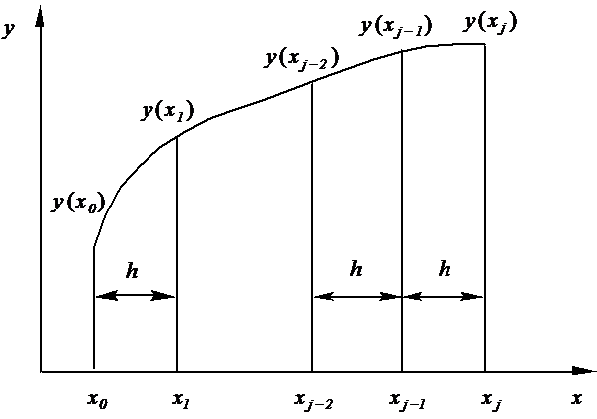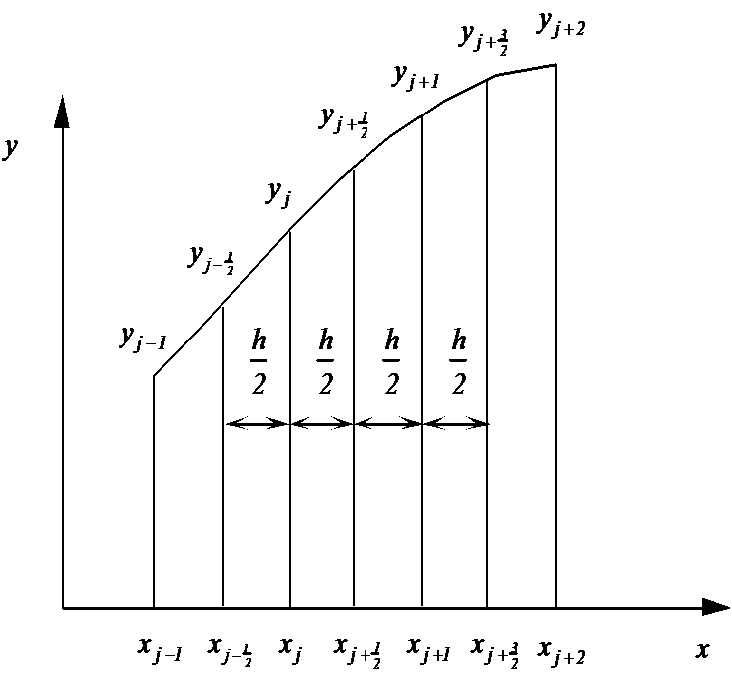Differences
We will study some simple methods to solve initial value problems. Later we shall see that these methods also may be used to solve boundary value problems for ODEs.

Figure 2: Illustration of how to obtain difference equations.

Forward differences: $$ \begin{equation*} \Delta y_j=y_{j+1}-y_j \end{equation*} $$
Backward differences: $$ \begin{equation} \tag{15} \nabla y_j=y_j-y_{j-1} \end{equation} $$
Central differences: $$ \begin{equation*} \delta y_{j+\frac{1}{2}}=y_{j+1}-y_j \end{equation*} $$
The linear difference operators \( \Delta \), \( \nabla \) and \( \delta \) are useful when we are deriving more complicated expressions. An example of usage is as follows, $$ \begin{equation*} \delta ^2y_j=\delta (\delta y_j)=\delta (y_{1+\frac{1}{2}}-y_{1-\frac{1}{2}}) =y_{j+1}-y_j-(y_j-y_{j-1})=y_{j+1}-2y_j+y_{j-1} \end{equation*} $$
We will mainly write out the formulas entirely instead of using operators.
We shall find difference formulas and need again Taylor's theorem: $$ \begin{align} \tag{16} y(x)=&y(x_0)+y'(x_0)\cdot (x-x_0)+\frac{1}{2}y''(x_0)\cdot (x-x_0)^2 + \\ &\dots + \frac{1}{n!}y^{(n)}(x_0)\cdot (x-x_0)^n +R_n \nonumber \end{align} $$
The remainder \( R_n \) is given by $$ \begin{align} R_n&=\frac{1}{(n+1)!}y^{(n+1)}(\xi)\cdot (x-x_0)^{n+1}\\ &\text{where } \xi \in (x_0,x) \nonumber \end{align} $$
By use of (16) we get $$ \begin{align} \tag{17} y(x_{j+1}) \equiv &y(x_j+h)=y(x_j)+hy'(x_j) +\frac{h^2}{2}y''(x_j)+\\ &\dots+\frac{h^ny^{(n)}(x_j)}{n!}+R_n \nonumber \end{align} $$ where the remainder \( R_n=O(h^{n+1}),\ h\to 0 \).
From (17) we also get $$ \begin{equation} \tag{18} y(x_{j-1}) \equiv y(x_j-h)=y(x_j)-hy'(x_j)+\frac{h^2}{2}y''(x_j)+\dots+\frac{h^k(-1)^ky^{(k)}(x_j)}{k!}+\dots \end{equation} $$
We will here and subsequently assume that \( h \) is positive.
We solve (17) with respect to \( y' \): $$ \begin{equation} \tag{19} y'(x_j)=\frac{y(x_{j+1})-y(x_j)}{h}+O(h) \end{equation} $$
We solve (18) with respect to \( y' \): $$ \begin{equation} \tag{20} y'(x_j)=\frac{y(x_{j})-y(x_{j-1})}{h}+O(h) \end{equation} $$
By addition of (18) and (17) we get $$ \begin{equation} \tag{21} y''(x_j)=\frac{y(x_{j+1})-2y(x_{j})+y(x_{j-1})}{h^2}+O(h^2) \end{equation} $$
By subtraction of (18) from (17) we get $$ \begin{equation} \tag{22} y'(x_j)=\frac{y(x_{j+1})-y(x_{j-1})}{2h}+O(h^2) \end{equation} $$
Notation: We let \( y(x_j) \) always denote the function \( y(x) \) with \( x=x_j \). We use \( y_j \) both for the numerical and analytical value. Which is which will be implied.
Equations (19), (20), (21) and (22) then gives the following difference expressions: $$ \begin{align} \tag{23} &y'_j=\frac{y_{j+1}-y_j}{h}\ ;\ \text{truncation error}\ O(h)\\ \tag{24} &y'_j=\frac{y_{j}-y_{j-1}}{h}\ ;\ \text{truncation error}\ O(h)\\ \tag{25} &y''_j=\frac{y_{j+1}-2y_j+y_{j-1}}{h^2}\ ;\ \text{truncation error}\ O(h^2)\\ \tag{26} &y'_j=\frac{y_{j+1}-y_{j-1}}{2h}\ ;\ \text{truncation error}\ O(h^2) \end{align} $$
(23) is a forward difference, (24) is a backward difference while (25) and (26) are central differences.

The expressions in (23), (24), (25) and (26) are easily established from the figure.
(23) follows directly.
(25): $$ \begin{equation*} y''_j(x_j)=\left(\frac{y_{j+1}-y_j}{h}-\frac{y_{j}-y_{j-1}}{h}\right)\cdot \frac{1}{h} = \frac{y_{j+1}-2y_j+y_{j-1}}{h^2} \end{equation*} $$
(26): $$ \begin{equation*} y'_j=\left(\frac{y_{j+1}-y_j}{h}-\frac{y_{j}+y_{j-1}}{h}\right)\cdot \frac{1}{2}=\frac{y_{j+1}-y_{j-1}}{2h} \end{equation*} $$
To find the truncation error we must use the Taylor series expansion.
The derivation above may be done more systematically. We set $$ \begin{equation} \tag{27} y'(x_j)=a\cdot y(x_{j-1})+b\cdot y(x_j)+c\cdot y(x_{j+1})+O(h^m) \end{equation} $$ where we shall determine the constants \( a \), \( b \) and \( c \) together with the error term. For simplicity we use the notation \( y_j\equiv y(x_j),\ y'_j \equiv y'(x_j) \) and so on. From the Taylor series expansion in (17) and (18) we get $$ \begin{align*} &a\cdot y_{j-1}+b\cdot y_j +c\cdot y_{j+1} = \\ &a\cdot\left[y_j-hy'_j+\frac{h^2}{2}y''_j+\frac{h^3}{6}y'''_j(\xi)\right]+b\cdot y_j + \\ &c\cdot \left[y_j-hy'_j+\frac{h^2}{2}y''_j+\frac{h^3}{6}y'''_j(\xi)\right] \end{align*} $$ Collecting terms: $$ \begin{align*} a\cdot y_{j-1}+b\cdot y_j +c\cdot y_{j+1} = \\ (a+b+c)y_j+(c-a)hy'_j+ \\ (a+c)\frac{h^2}{2}y''_j+(c-a)\frac{h^3}{6}y'''(\xi) \end{align*} $$ We determine \( a \), \( b \) and \( c \) such that \( y'_j \) gets as high accuracy as possible: $$ \begin{align} a+b+c=0 \nonumber \\ (c-a)\cdot h=1 \tag{28}\\ \nonumber a+c=1 \end{align} $$ The solution to (28) is $$ \begin{equation*} a=-\frac{1}{2h},\ b=0 \text{ and } c=\frac{1}{2h} \end{equation*} $$ which when inserted in (27) gives $$ \begin{equation} \tag{29} y'_j=\frac{y_{j+1}-y_{j-1}}{2h}-\frac{h^2}{6}y'''(\xi) \end{equation} $$ Comparing (29) with (27) we see that the error term is \( O(h^m)=-\frac{h^2}{6}y'''(\xi) \), which means that \( m=2 \). As expected, (29) is identical to (22).
Let's use this method to find a forward difference expression for \( y'(x_j) \) with accuracy of \( O(h^2) \). Second order accuracy requires at least three unknown coefficients. Thus, $$ \begin{equation} \tag{30} y'(x_j)=a\cdot y_j + b\cdot y_{j+1} + c\cdot y_{j+2} + O(h^m) \end{equation} $$ The procedure goes as in the previous example as follows, $$ \begin{align*} a&\cdot y_{j}+b\cdot y_{j+1} +c\cdot y_{j+2} =\\ a&\cdot y_j+b\cdot\left[y_j+hy'_j+\frac{h^2}{2}y''_j+\frac{h^3}{6}y'''(\xi)\right]+\\ c&\cdot \left[y_j+2hy'_j+2h^2y''_j+\frac{8h^3}{6}y'''_j(\xi)\right]\\ =&(a+b+c)\cdot y_j+(b+2c)\cdot hy'_j \\ +& h^2\left(\frac{b}{2}+2c\right)\cdot y''_j+\frac{h^3}{6}(b+8c)\cdot y'''(\xi) \end{align*} $$ We determine \( a \), \( b \) and \( c \) such that \( y'_j \) becomes as accurate as possible. Then we get, $$ \begin{align} a+b+c=0 \nonumber\\ (b+2c)\cdot h=1 \tag{31}\\ \frac{b}{2}+2c=0\nonumber \end{align} $$ The solution of (31) is $$ \begin{equation*} a=-\frac{3}{2h},\ b=\frac{2}{h},\ c=-\frac{1}{2h}\ \end{equation*} $$ which inserted in (30) gives $$ \begin{equation} \tag{32} y'_j=\frac{-3y_j+4y_{j+1}-y_{j+2}}{2h}+\frac{h^2}{3}y'''(\xi) \end{equation} $$ The error term \( O(h^m)=\frac{h^2}{3}y'''(\xi) \) shows that \( m=2 \).
Here follows some difference formulas derived with the procedure above: